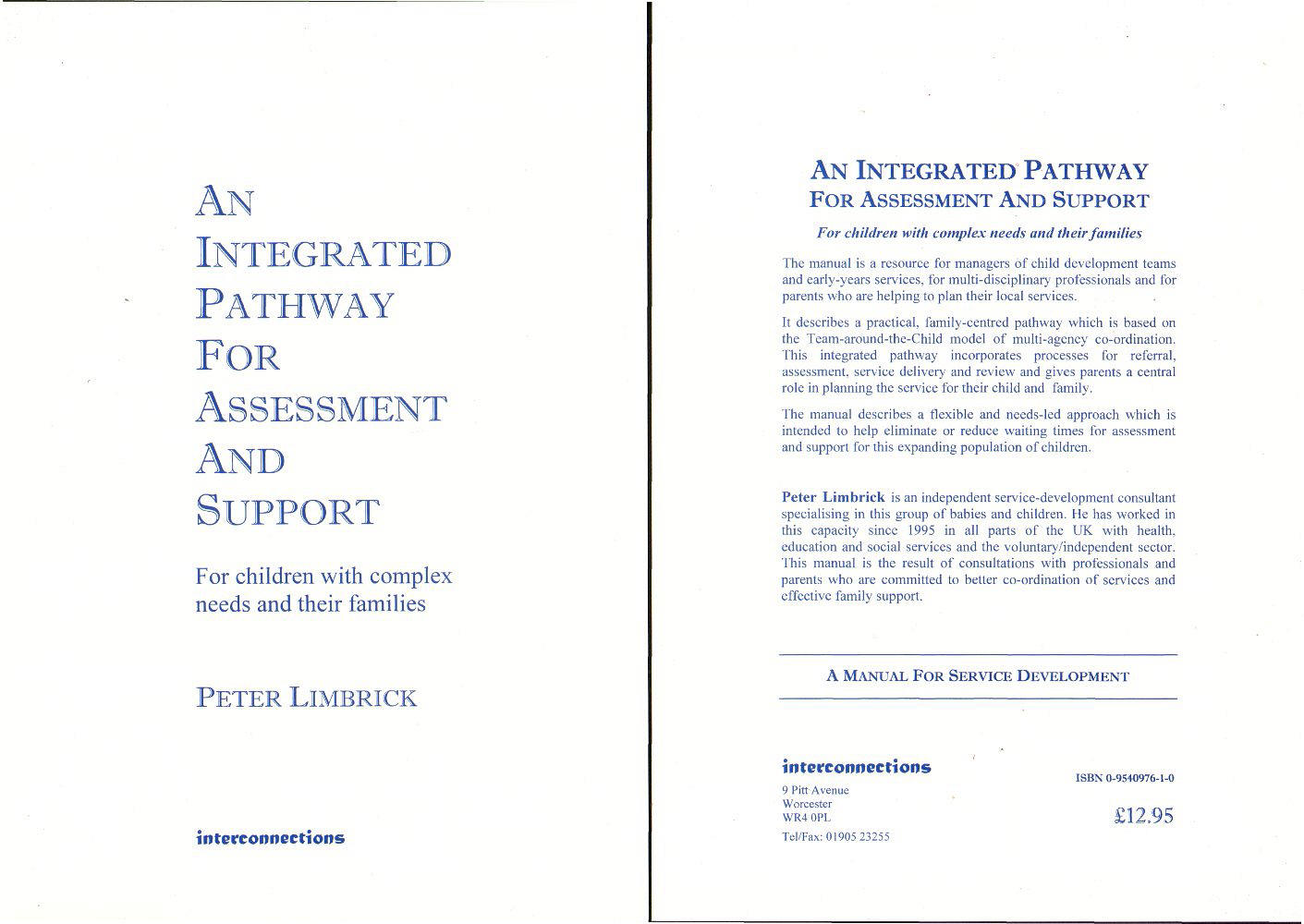An Integrated Pathway for Assessment and Support. For children with complex needs and their families. The whole book as a free PDF
By Peter Limbrick in 2003
Introduction
This manual is about babies and young children with disabilities who have complex needs. They represent an expanding population and they highlight the need for services to be more organised, more integrated, more family-centred and more accountable. The manual suggests how health, education, social services and the voluntary/independent sector can work together to provide these children and their families with an effective service.
Some terms used in this manual
'Children with complex needs'. Some services define these children as children who need continuing support from two or more practitioners from one or more agencies. Another approach is to define them as children (and families) who require a complicated service. This group will include some children with continuing health needs and some with life-limiting conditions.
'Agencies, services and localities'. ‘Agency’ refers to the statutory agencies of health, education and social services and to voluntary and independent organisations. Within these agencies there is a variety of services, teams, centres, projects and units which help young children with complex needs. This manual uses the term ‘service’ to represent them all and assumes that most services will have some integration between disciplines if not between agencies. The term ‘locality’ is used for the administrative/geographical area covered by the service or agency.
'Practitioner'. This word is used to refer to all the professionals or paid workers who help the child and family. It can include (in alphabetical order) dieticians, geneticists, health visitors, keyworkers, nurses, nursery nurses, paediatricians, play leaders, Portage teachers, psychologists, social workers, specialist teachers, therapists and others. Practitioners who have a hands-on involvement with the child and family are distinguished from ‘service managers’ though it is recognised that in many cases it is a dual role.
'Support'. ‘Support’ is used in this manual to bring together many elements of service provision. Support for the child includes provision of play activity, education, therapy, treatment and care. Support for the parents can include emotional support, provision of information, mentoring and advocacy. Support for the family can also include support for siblings, grandparents and other significant members of the family - however it chooses to define itself.
'Assessment events and assessment processes'. There are many approaches to assessment. At one end of the spectrum is the one-day child-assessment event and at the other is the family-centred assessment process over a much longer period of time. Assessment and support are not mutually exclusive. The practitioner is learning more about the child and family while he or she is providing support and, ideally, offering relevant support during any assessment activity. This is reflected here in the term ‘assessment/support process’.
The purpose of this manual
This manual is intended as an aid to service development for all services and agencies which support babies and pre-school children with complex needs and their families. It encourages and facilitates the description of a service in terms of a pathway which can be represented diagrammatically and acknowledges that pathways will be unique to their own locality. The manual can be used by services at increasing levels of integration. It can be used by a multi-disciplinary team to describe and then improve its own integrated service. It can be used by a panel of senior managers from two or more agencies to create an integrated multi-agency pathway for the locality.
The manual does not offer any new invention or theory. It brings together models of good practice which the author has seen in all parts of the UK and Ireland and builds them into an accountable system which can be described, resourced, monitored and evaluated. The approach embodies the spirit of the NHS Plan by advocating modernisation, some breaking down of professional boundaries and improved partnership between agencies.
The layout of the manual
Integrated pathways: This section discusses the merits of integrated pathways and offers a structure for describing and enhancing a pathway for a multi-disciplinary or multi-agency service.
A flexible approach to assessment: This section discusses assessment procedures and suggests a flexible approach which can reduce waiting times.
Designing an integrated pathway: This section offers a detailed approach to designing an integrated pathway which incorporates the Team-around-the-Child model.
In conclusion: This section suggests some key issues to consider in modernising services and offers sources for further information.
For the free PDF of the whole book: https://tacinterconnections.com/images/IntegPman.pdf


